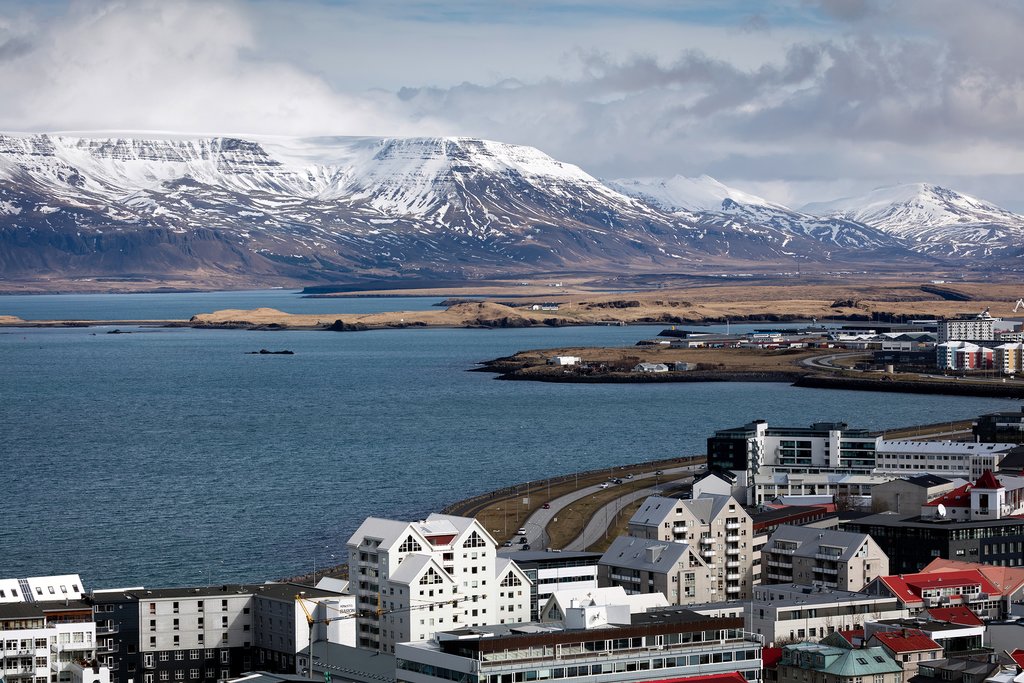Weather
Though the weather is still quite wintry (snow is always right around the corner), there are a handful of warmer, sunnier days that encourage budding flowers and plants.
Temperatures range between 34- and 45-degrees Fahrenheit often enticing natives to go swimming outdoors. And with the ever-increasing daylight hours, 13.5 at the start of the month and 16.5 toward the end (even more hours in Northern Iceland), you can expect better driving conditions too, granting smoother access throughout the island.
On the whole, April is a more pleasant month than March. Packing layers, a waterproof jacket, and comfortable walking shoes with good grip for all sorts of terrain is your best bet to be prepared for the changeable weather.
Crowds & Costs
April transitions into shoulder season, the slightly more agreeable weather bringing tourists with it, though you can still expect to find cheaper accommodation than in the summer and winter (upwards of 50% cheaper). Locals love their Easter family traditions, with roast lamb and chocolate and candy exchanges, and spring skiing in the mountains has many Icelanders traveling within the country during this period as well.
Where to Go
As the daylight hours continue to increase, there is less snow and ice (on average) therefore offering better road conditions for renting a car and exploring at your own pace. Most travelers will either start or end their trip with a few days in the capital of Reykjavík. A classic next stop from here is to discover popular attractions along the Golden Circle and Southern Shore routes, beginning with Thingvellir National Park and ending at the rugged coastline of Vík and Dyrhólaey.
If time is on your side, continue to circumnavigate the small island as you follow the Ring Road east (being mindful of poor driving conditions and in some cases road closures). Some highlights include Jökulsárlón Glacier Lagoon, Diamond Beach, and the rugged fjord coastline of the eastern coast (Höfn, Vestrahorn mountain, wild reindeer, and the stunning village of Seyðisfjörður). You can also experience the mountains, hot springs, and craters of the northern coast ( Mývatn, Dimmuborgir, Goðafoss, Akureyri) and make a detour to the Westfjords, Snæfellsnes peninsula, and Reykholt.
For alternate travel itinerary options read up on our 7 Unique Self-Drive Itineraries.
Chat with a local specialist who can help organize your trip.
What to Do
With slowly increasing daylight hours and temperatures, visitors will discover that most summer activities are available to them as well as have the added bonus of potentially spotting the Northern Lights. Your best bet is to stick closer to the Arctic Circle in the north of the country. Though if you join a tour (boat, Super Jeep, or bus) or rent a car and get away from the city’s light pollution, the odds are in your favor. Read Tips for Viewing the Northern Lights in Iceland for more information.
Animal lovers will want to take advantage of the season and head to Látrabjarg, the westernmost point of Iceland (and Europe) in the Westfjords, to see hundreds of thousands of nesting Atlantic puffins among other seabirds, like Arctic terns, razorbills, and guillemots. Alternatively, you can book a combined whale-watching and horse-riding tour with a puffin seeking excursion to get up close and personal with the cute birds.
A unique way to experience the Icelandic rugged terrain is to join a snowmobile tour and cross over snowfields and on top of ancient glaciers, like the Langjökull glacier, all in the light of the summer sun. Head to Skaftafell in the Vatnajökull National Park to test your glacial climbing skills or hike Svartifoss, a 65-foot waterfall bordered by black basalt columns, creating an otherworldly scene. End the day with a relaxing soak in one of the many warming thermal pools or hot springs, like the world-famous Blue Lagoon spa or northern Iceland’s popular Mývatn Nature Baths after a long day of sightseeing in the unpredictable, and likely windy weather.
For more on what you can expect to see in southern Iceland, check out this Ultimate Guide.
Events in April
Easter Week. Icelanders take a five-day holiday from Holy Thursday to Easter Monday to spend time with family. Locals welcome visitors into their homes to share smoked lamb and huge chocolate eggs.
Reykjavík Children’s Culture Festival. Dedicated to children and youth, this week-long annual festival features a variety of art disciplines through the medium of workshops and performances.
Sumardagurinn fyrsti. According to the old Norse calendar, Sumardagurinn fyrsti marks the first day of summer (and the first Thursday after April 18th). A public holiday, you can expect city-wide closures, parades, and sports.
Aldrei fór ég suður (I Never Went South). A Rock music festival that takes place the end of the month and wakes Ísafjörður, in the west of the island, from its winter slump.
Traveling to Iceland in April? Check out these great itineraries.
2-Week Self-Drive: Highlights of Iceland and the Remote Westfjords. With 2 weeks in Iceland, you can complete the entire ring road and add some great detours. This grand tour will take you to all the best places giving you plenty of time to hike, explore, and soak it all in. This 14-day itinerary covers all the major regions except the highlands, which you can see with a couple more days or by spending less time in some of the areas below.
7 Days in Iceland - 4 Unique Road Trip Itineraries. With 7 days in Iceland, we recommend you hit the road and explore the incredible wonders further afield from Reykjavik. We’ve put together these unique one week Iceland itineraries which let you explore a variety of landscapes: volcanoes and lava fields, green pastures and farmlands, scenic vistas above fjords, beaches of every color, glaciers and ice caves, and the rugged interior. Here are our recommended drives, an option for all travelers and seasons.
More Helpful Information
Iceland in March
Iceland in May
Best Time to Visit Iceland
More Iceland Itinerary Ideas
